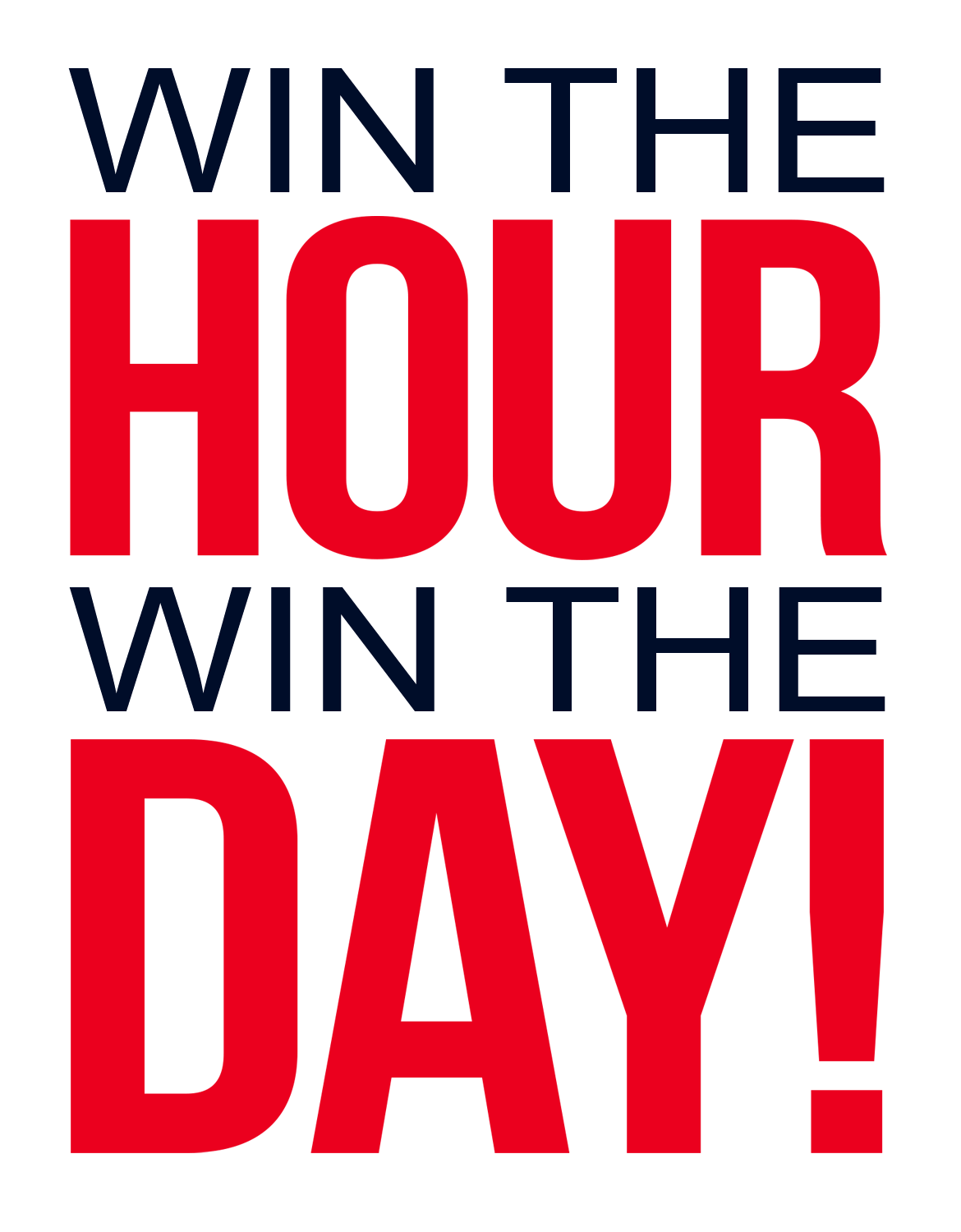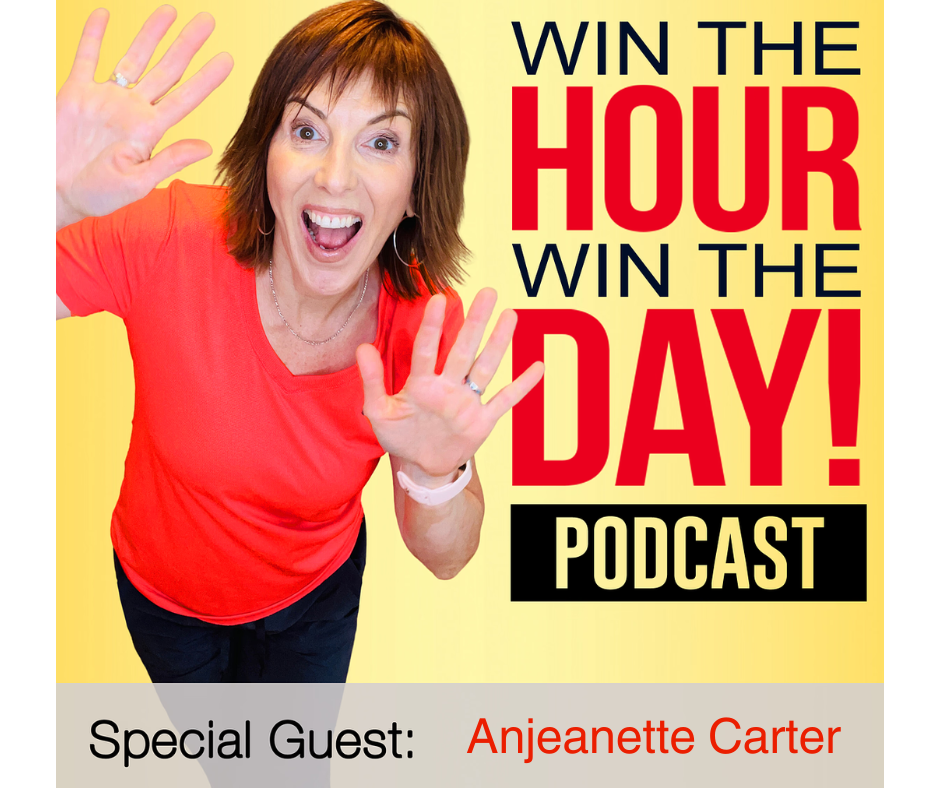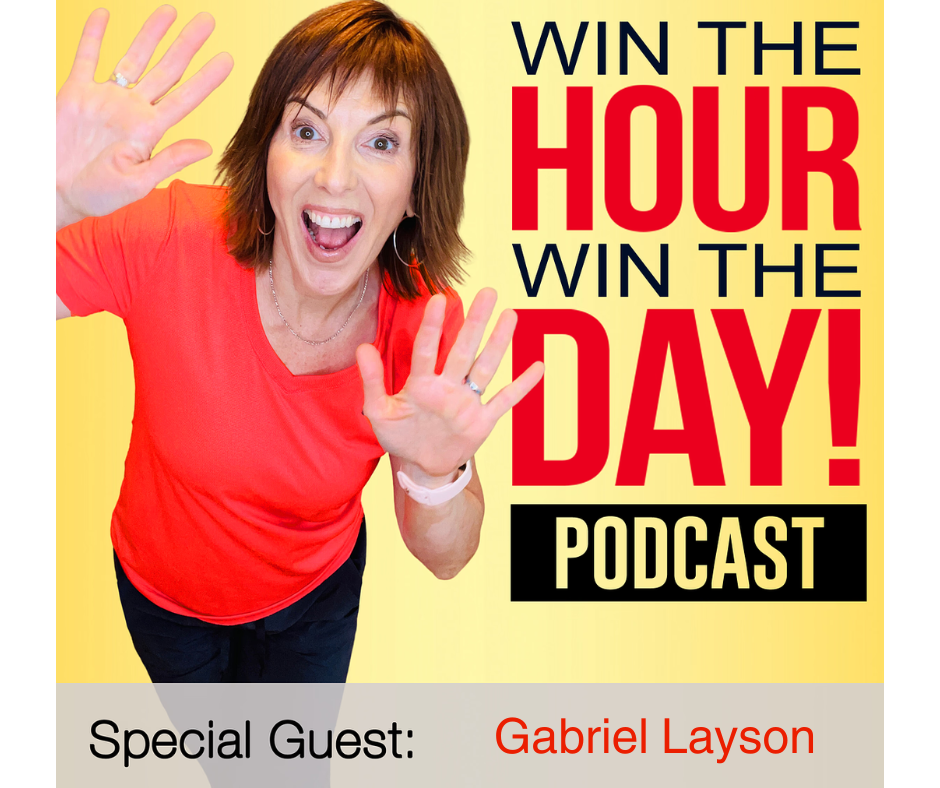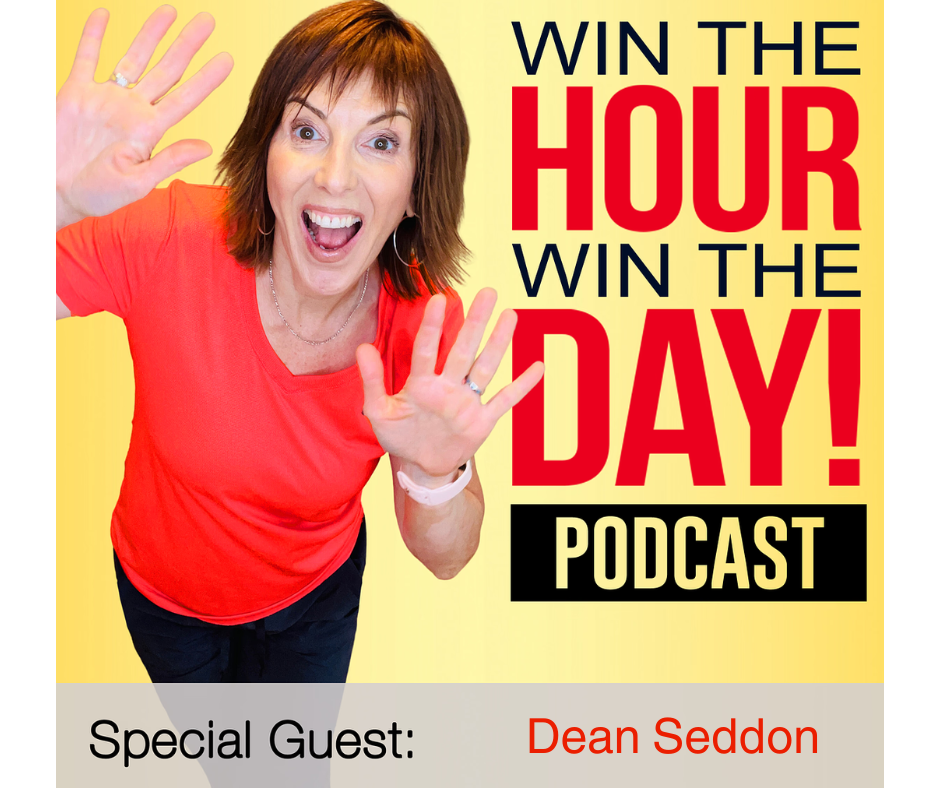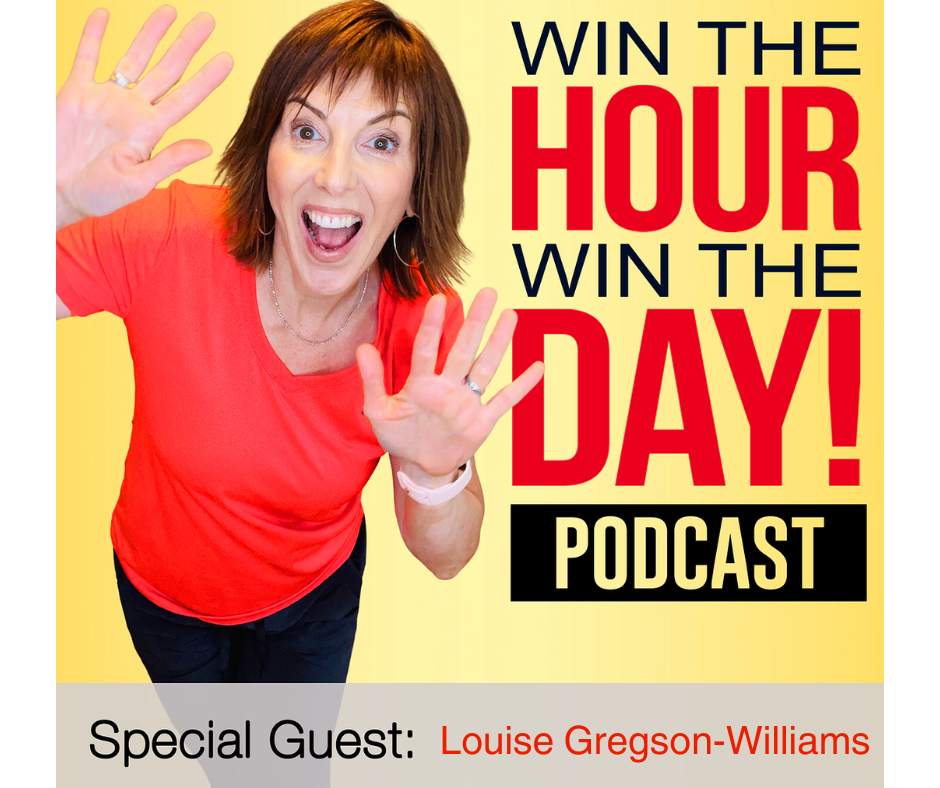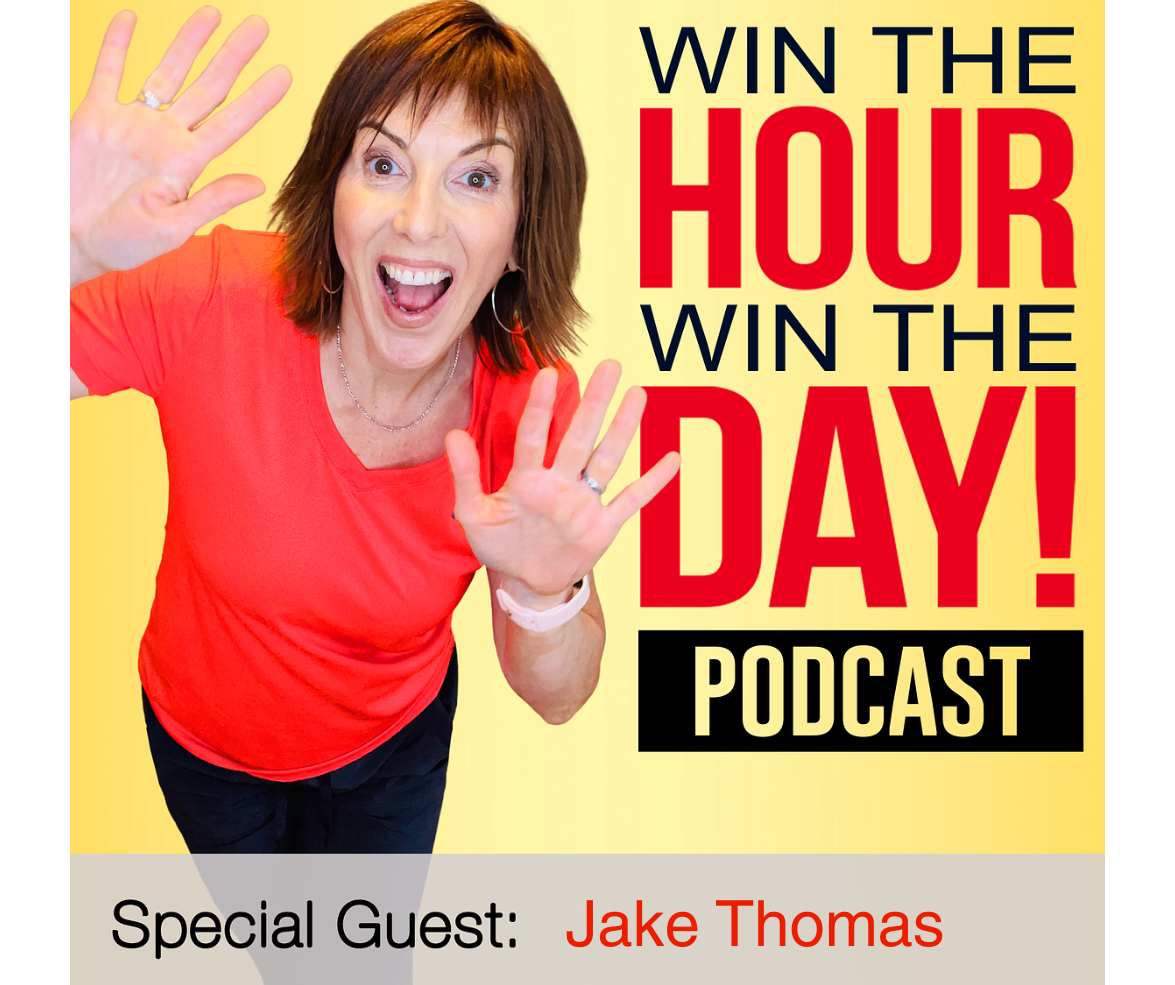Episode Summary
This week’s episode of Win The Hour, Win The Day Podcast interviews, Anjeanette Carter.
Do you want more people to notice your LinkedIn posts? Join us as Anjeanette Carter shows how to write posts that grab attention and keep readers hooked.
In this powerful talk, you’ll learn:
-Why the first two lines (the hook) decide if your post gets read.
-How short lines and white space make posts easier to follow.
-The best way to tell a story that people relate to.
-Why insight matters more than long lists or lectures.
-How to use call-to-actions that spark comments and boost reach.
Get ready to learn how simple changes can make your LinkedIn posts go further. Don’t miss this chance to make your posts clear, engaging, and worth reading.
Win The Hour, Win The Day! www.winthehourwintheday.com
Podcast: Win The Hour, Win The Day Podcast https://podcasts.apple.com/ca/podcast/win-the-hour-win-the-day/id1484859150
Facebook: https://www.facebook.com/winthehourwintheday/
LinkedIn: https://www.linkedin.com/company/win-the-hour-win-the-day-podcast
You can find Anjeanette Carter at:
LinkedIn: https://www.linkedin.com/in/anjeanette-carter/
Substack: https://anjeanettecarter.substack.com/
#KrisWard
#ViralLinkedInPosts
#LinkedInContentStrategy
Win The Hour Win The Day
https://winthehourwintheday.com
Anjeanette Carter Podcast Interview
[00:00:00] Kris Ward: Hey everyone. Welcome to another episode of Win The Hour, Win The Day. I am your host, Kris Ward, and today in the house we have Anjeanette Carter and she is a LinkedIn Management and Ghost Writer. Alright, we’re gonna get into it and we’re gonna come at it from a different perspective. But first of all, welcome to the show Anjeanette.
[00:00:17] Anjeanette Carter: Thank you Kris. So happy to be here.
[00:00:19] Kris Ward: Okay, good. All right. So yeah, LinkedIn’s, it’s just in the forefront. It seems like it’s all we’re talking about these days, but it’s really strong and powerful is where so many of our clients are, and the ones that can afford us.
[00:00:32] Kris Ward: So today we’re gonna talk about the anatomy of a viral post. So where do we start with that? We’re gonna be putting content on LinkedIn. We can’t get around it. We have to do it. So we want these posts to have some impact. Where do we start?
[00:00:48] Anjeanette Carter: Where do you start? That’s a great question. So again, yes, any, most entrepreneurs, especially in the B2B space, are on LinkedIn.
[00:00:56] Anjeanette Carter: I work with founders and CEOs every single [00:01:00] day who are wanting to grow their personal brand so they can ultimately grow their business. Yeah, and as far as content, that’s really where it all starts. ’cause that is where people find you. This is where you get to showcase your authority and your credibility, but if you don’t post, no one’s gonna know about you.
[00:01:18] Anjeanette Carter: Yeah. We gotta start with that post
[00:01:20] Kris Ward: and let me jump in there for a second because it is shocking. They keep giving us staggering statistics that some insane amount of people aren’t posting. Like 92% of people aren’t posting or something like that, which I don’t know. ’cause LinkedIn seems crowded to me.
[00:01:32] Kris Ward: It seems like there’s a lot going on, so I don’t get it. But let’s be clear. You do need to post. They don’t know you’re there unless you post. All right. We’re posting.
[00:01:40] Anjeanette Carter: Yes. And again, that’s a great point because right now you can still be a big fish in a small pond. Okay. Because it, it is the gold rush of LinkedIn right now because people are just starting to take notice.
[00:01:52] Anjeanette Carter: So the right people are there looking, starting to interact with community, but they’re still tons. There’s still [00:02:00] tons of room for growth because there’s so many people, like you said, most are not on there, so now is the time to take advantage. So when you’re gonna write that post, the very first thing that matters.
[00:02:11] Anjeanette Carter: In fact, I like to argue the only thing that matters. Okay. Not the only thing, but the most important thing that determines the rest is the hook.
[00:02:21] Anjeanette Carter: Yeah.
[00:02:22] Anjeanette Carter: Did you know when you were scrolling on LinkedIn. Think about when you scroll, you only see the first two sentences of somebody’s post. Yeah. Then you have to click like. Read more to actually see the rest. So if you don’t hook someone in those first like sentence or two, it’s over. They’re not gonna read it. So let’s talk about the hook, Kris.
[00:02:45] Kris Ward: Okay, let’s jump in for a second. ’cause I think of important distinction here. Where we get confused is, I’ve done this where I’m thinking of a title versus a hook.
[00:02:55] Kris Ward: So I’m writing an article about the five biggest mistakes that [00:03:00] whatever people make with hiring a virtual assistant. That’s not the, that’s not a bad hook, but what I would say is often you think you’re like, when you’re writing it, it’s so easy to think, oh, this is the title, what I’m talking about, confusing that with a hook.
[00:03:15] Anjeanette Carter: That’s an excellent point. ‘cause yes, remember LinkedIn posts are not articles, right? You can’t write an article on LinkedIn, but this is not, that. Posts are not,
[00:03:24] Kris Ward: even the article needs a hook.
[00:03:25] Anjeanette Carter: Of course. Yes, absolutely. But yes, do not title anything. This isn’t an essay. You’re not getting graded?
[00:03:31] Kris Ward: No, because we all get confused from school. If I was writing an essay on whatever the Brown Bear, in Canada, that would be the title of my essay. I wouldn’t be like trying to get your attention of the grizzly fallout of our biggest beast. That wouldn’t have been it.
[00:03:46] Kris Ward: And so I think it’s really important. A lot of times, or especially in the beginning, I was thinking I had a hook, but I had a title.
[00:03:53] Anjeanette Carter: Great distinction. And yes, the hook is everything. I imagine we are gonna spend more time talking about [00:04:00] this hook Yeah. Than the other four aspects combined because this, it is that important and yes, a title is not a hook. And you know why? Because we don’t talk to each other in titles, right?
[00:04:11] Anjeanette Carter: Yeah. So if you are listening out there and you’re thinking, oh, what my next post is gonna be, et cetera. You don’t need a title because you’re not, you don’t talk in TI Titles.
[00:04:20] Anjeanette Carter: Yeah. You want to write how you would speak. Yeah. What is something you could say that gets someone’s attention?
[00:04:26] Anjeanette Carter: So some elements of a great hook. You need to show immediate curiosity or tension. Maybe you’re speaking directly to a pain point, maybe a bold claim. Something that challenges opportunities. Like one thing I wrote recently was you have five seconds for so to, for your LinkedIn post to go viral or not.
[00:04:48] Anjeanette Carter: Oh, that, that makes you think, I didn’t say here’s a way to determine if you’re gonna go viral. No one cares. Yeah. Yeah. It’s like you wanna grab attention, you, the attention economy is short. And in this case, you, the good news is, you know what it [00:05:00] is, it’s two lines. Yeah. One or two lines.
[00:05:02] Anjeanette Carter: And if you don’t get ’em in that hook. It’s you’ve, the rest literally doesn’t matter because no one’s clicking and no one’s reading. So I like to formulate my hooks before I write anything I don’t. Hook is not, last hook should be first. If you don’t have a good hook don’t write the post. Even if you think, oh, this is a really good idea, but if you can’t get a catchy or hooky hook. Don’t even post it
[00:05:26] Kris Ward: write that down everybody. A hooky hook. Hooky hook. I need Jersey
[00:05:28] Anjeanette Carter: Hooky hook.
[00:05:29] Kris Ward: Okay.
[00:05:29] Anjeanette Carter: I need a hooky hook.
[00:05:31] Kris Ward: That does make sense though. And I have to say I don’t do it that way. I’m like, okay, I’ve got this thing I wanna write about. And so then you write it. I guess because it was beaten into me when I was in school, all of us, because I was, you say, write the whole essay and then do, because I was very organized in school and had everything looking lovely.
[00:05:50] Kris Ward: Now don’t confuse that with the fact that I had no substance in anything I did. My books looked organized. ’cause yes, I’m organized and I do all these things, but I would be tempted to make the title page [00:06:00] look nice and color it and do all these things in grade two or three, and there is no content in my essay, but the title page looked good.
[00:06:06] Kris Ward: It’s always about, Hey, get your content first. Worry about that later. But in this case, the content is the hook. ’cause without the hook, you got nothing.
[00:06:14] Anjeanette Carter: Exactly.
[00:06:15] Kris Ward: Okay.
[00:06:15] Anjeanette Carter: So hook is everything.
[00:06:17] Kris Ward: Okay. So that, yeah, it’s all right. And I’m really wrapping my head around that, but it makes so much sense because without it, we, it doesn’t matter how great the content is, nobody is going to open that, flip open the cover, walk in the door, whatever.
[00:06:29] Kris Ward: So we have to hook. Okay. Hook is huge. Got it.
[00:06:33] Kris Ward: Yes. Should we move on to the next? Yeah, sure. Okay. Hook is huge. The next one? Yep.
[00:06:37] Anjeanette Carter: So we’ve got the hook. And again, if you watch nothing else and learn nothing else from this, the hook is number one. Okay. That’s why we speak about it first.
[00:06:45] Anjeanette Carter: Number two, before we get into what you’re writing about, keep in mind when you’re writing. Number two is the structure. Okay? It’s all about readability. Now, if you scroll on LinkedIn or any social platform for [00:07:00] that matter, and you see someone that you like to read, someone that you like, and then you see they’ve posted this.
[00:07:06] Anjeanette Carter: Like a big chunk. Yeah. Big long paragraph. Yeah. You’re gonna be like, oh no, I’m busy. Even though you’re not busy. Yeah. It’s just a psychological trigger that we see something too big and we don’t, we just scroll right past it ’cause it just looks long.
[00:07:17] Kris Ward: Okay, so those, let me just jump in for the, for our audio audience, what you’re talking about is a big two inch paragraph and what matters is my Lord. I have written, not written. I have read books and taken courses on white space, like it’s crazy. And so what happens is you see this big chunk of a paragraph and there’s a commitment to read that. But if you break down your post into short little sentences. When the eye lands on it, you’re also forced to read it.
[00:07:43] Kris Ward: Like you see one little sentence with five words. You can’t help but read it. You see a paragraph coming at you, you duck.
[00:07:49] Anjeanette Carter: Exactly. Like we can all commit to reading one line. Yeah. Like we can all do it. Like our brains will allow us to be like, okay, this is not gonna take too much time. Yeah.
[00:07:57] Anjeanette Carter: And so it’s, now I wanna stress it is [00:08:00] okay if you naturally are the kind of person when you write stuff, you do write big paragraph and paragraphs and chunks. Write it that way. That’s fine. When you’re writing it. Yeah. You could write it that way. But when you’re done writing, yeah. You need to go through and start breaking it up.
[00:08:15] Anjeanette Carter: Break up. Yeah. I don’t want, I never usually put more than two sentences.
[00:08:19] Anjeanette Carter: Yeah. And a lot of times I like to do one sentence and then white space. So one to two sentences max. And again, the good news is you don’t have to retrain yourself to write that way. You just need to, when you’re done writing, take a look.
[00:08:33] Anjeanette Carter: Yeah. And make sure before you hit post that you break it up for the readability in white space.
[00:08:38] Kris Ward: A hundred percent. ’cause what I say to my team is people are reading with their thumb, they’re scrolling by, so the, and then when you scroll by and one sentence, you’re like, oh wait, hold on, back up.
[00:08:47] Kris Ward: What do I think I need to read this, but if they see a paragraph, they’re not reading that one sentence. Got it. Okay. Exactly. So the structure is huge. Okay.
[00:08:56] Anjeanette Carter: Absolutely. Absolutely. So structure is important, right? [00:09:00] Because the hook, if the hook’s not good, no one’s reading it. Yeah. If the structure is poor, no one’s gonna read it.
[00:09:04] Anjeanette Carter: So overwhelming.
[00:09:05] Anjeanette Carter: Yeah.
[00:09:05] Anjeanette Carter: But now let’s say you’ve got your hook, you’ve got your killer hook, and you know you’re gonna break it up for white space. You’ve got the readability down.
[00:09:13] Anjeanette Carter: Yeah. Now. Now’s the meat and potatoes. What are you actually gonna write? So now,
[00:09:18] Anjeanette Carter: okay.
[00:09:18] Anjeanette Carter: The third element of a viral LinkedIn post is the story.
[00:09:24] Anjeanette Carter: This is, like I said, this is the meat and potatoes. This is what you’re actually writing about. This is where you wanna give details. Be, write something that is relatable. I don’t mean act relatable. Yeah. Whatever the point is, whatever you’re writing about, it’s gotta be something that others can relate to.
[00:09:41] Anjeanette Carter: It’s gotta be interesting. Maybe have some tension, but whatever it is you need to. Put the details, make it interesting. And most of us, when we do that, we go on tangents and we write. That’s okay when you’re in your draft, but when you read it, [00:10:00] always think about editing. You wanna, I like that there’s a line in screenwriting.
[00:10:05] Anjeanette Carter: That I used to do, that I like to apply to copywriting and ghostwriting as well. Which is like when you’re, when you come to a scene, like in a movie Yeah. A scene as a writer, you wanna come late and leave early.
[00:10:17] Anjeanette Carter: Okay.
[00:10:17] Anjeanette Carter: And I like to apply that to writing posts as well in that people are gonna catch up.
[00:10:22] Anjeanette Carter: You don’t need too much backstory and you don’t need to stick around and hammer your point home. You gotta come in right with it. Make your point. Get out.
[00:10:33] Kris Ward: Yeah, that’s a good point. On a couple elements, because I know when you’re telling a story, and I struggled with this on video for a long time, is sometimes you tell the story before the story, so you’d be like okay. I was shopping with my, I’ll do it. Yeah. I was shopping with my niece and she visits every couple months and she comes from Ontario and this is great and whatever. So we were out shopping and this, it’s I don’t need to explain. They don’t care that my niece, no one cares.
[00:10:55] Kris Ward: So you’re thinking, you’re explaining why I was with her. ’cause she’s not normally here and she’s visiting. But [00:11:00] that’s not relevant, so we include all these extra details. So I think that’s really important is the elements of the story is just keep it clean, trim it down. Just get to the point, grandpa.
[00:11:11] Anjeanette Carter: And it’s important that to speak to what you just said. When you give all that backstory, it’s like you’re qualifying yourself. Yes. You don’t need to qualify yourself. Okay? This is your post, right? So anytime you think, oh, is this too long? Did I say too much? Maybe ask yourself, when you reread it, am I qualifying myself?
[00:11:31] Anjeanette Carter: Because you don’t need to you’re qualified. I give you permission, write your own post that.
[00:11:36] Kris Ward: That’s really interesting. ’cause recently I put up a post and I was trying the story thing, ’cause I wanna make two points. One is when someone makes a story that they try to fit and it’s clunky and it’s like they’re trying to nail down a point and they sound like they’re selling insurance.
[00:11:48] Kris Ward: Like tying in a life lesson to a business story and there’s the bridge is just weak, right? So that’s my pet peeve then. The other thing is recently I did a post and it was just a simple [00:12:00] story of I went into a store and this makes me nuts when you go, they ask for whatever, oh, it’s $260.
[00:12:07] Kris Ward: And then you know you’re buying clothes. And then they say, would you like to buy a 50 cent bag for, to carry your possessions out? And you’re like okay. Now I am like, you just pushed my hot button and now we’re ruining this really good experience. ’cause I just went shopping here. Now you’re asking me for a 50 cent paper bag.
[00:12:23] Kris Ward: So I wrote a very short post about this, and I had to clean up the post because I felt you’re right, the need to explain. I was with my niece because I wouldn’t be spending that kind of money on me. Here I am shopping with her. So I had to take that out like people. People would I, I said I spent this couple hundred dollars, that’s fine.
[00:12:42] Kris Ward: That’s not the point of the story. Move on. So I didn’t need her in the story, even that’s what was happening. I was buying her clothes, clean up the story, get to the point. The point is I spend a lot of money. They then asked me to carry my possessions over for 50 cents. That’s crazy. And it got so many.
[00:12:58] Kris Ward: I don’t even know where we’re at now. It’s [00:13:00] something like 12,000 impressions. I don’t know, like a couple hundred likes, a couple hundred comments, and it was just a general story, right? Really short and to the point. And I think that speaks to the power of the simplicity and clarity of a good story.
[00:13:14] Anjeanette Carter: ‘Cause people related to that, they don’t relate to you shopping with your niece. Even if they have a niece. Yeah. That’s not that’s not the part of the story that matters. The part of the story that matters is the part that we all relatable. That that we all relate to. Yeah. Which again, brings us to number four.
[00:13:29] Anjeanette Carter: Which is the insight. Okay? So you have your story, you have your topic, what you’re writing, but then the insight is basically the point, like your point with the supermarket post is that you just spend a ton of money and boom. Now they’re souring it by just trying to squeeze you for just a little more. Can you pay? Can you gimme
[00:13:50] Kris Ward: I had to clarify, God, this was the part where I almost defended myself. It was closed, not supermarket, so I spent that on closed. So that’s why I was like gonna be like, oh no, I have to tell people I was with my knees. But yeah, so that’s the point is you’re [00:14:00] right, the insight was now you’re gouging me for 50 cents. We talking about here.
[00:14:04] Anjeanette Carter: I just spent like almost $300. Yeah, exactly. And so that. Is the insight. Yeah. And so your insight, remember everything. The only reason people read anybody’s posts. If it didn’t happen by accident is, it means the reason they read your post is because they add value and people find your post valuable.
[00:14:24] Anjeanette Carter: That is the only reason someone’s gonna read your post, is because they find it valuable. The insight is where the value is. So this is where you either deliver the unexpected lesson a new perspective like Kris, her perspective, your perspective was, oh, like this is insanity that I spent 300.
[00:14:42] Anjeanette Carter: Yeah. And someone you know who else can relate and agree. Yeah. That was the insight of that post. Sometimes it’s an action that someone can implement immediately. You want if you’re giving advice. You want them, you want it to be something that can be implemented right away. So your insight is the actual crux, the point, the main value. So when you read, you have your story. ’cause we all know how to tell stories, but when you’re done reading the draft that you wrote, make sure that you say, oh, okay, but where’s the value? How does it help someone that’s insight?
[00:15:14] Kris Ward: I think you just gave me aha. Aha moment because I think up until now when people always talked about giving value, Oh, we should give value. Give value, great. That does
[00:15:23] Kris Ward: that mean and I have ran into a couple problems with that. One is, so I think my value is educating you and so then it makes a post clunky and long ’cause I’m trying to get some points, and again, now I’m trying to explain the thing I have to explain like.
[00:15:35] Kris Ward: I’m making it too long ’cause I’m giving you information, not transformation. And so for your point here, when you say the insight is where the value is, it can be insightful and just have a little nugget. Hey, you’re right. This is crazy. I shouldn’t have been spending, but now it changes my whole perspective, a lesson.
[00:15:49] Kris Ward: Yeah, everything’s not a life lesson. It’s, for example, your audience, you speak to entrepreneurs, et cetera. Talking about buying a bag at a, in a shopping experience isn’t exactly an [00:16:00] entrepreneurial experience, but it’s okay because it’s a human experience and it’s something we all relate to.
[00:16:04] Kris Ward: So even though it’s as an add value in the sense of, to, win the hour, win the day. It adds value as a human. And someone like myself reads that and goes, oh yes Kris, that’s why I like you.
[00:16:17] Kris Ward: But even more than that, I agree with everyth you say, but I think that even taking that into writing my posts at were about the business I could have insight to.
[00:16:26] Kris Ward: Here’s why. VAs are going to ghost you, and no one talks about this. There’s insight there. Where I was seeing before, the value is I was almost having to solve the problem, right? I was always having to give people instructional steps that made it a clunky post. That’s the confusion there. So I think for me, under using you, using that word insight is more liberating and freeing for me.
[00:16:48] Kris Ward: Then value, I felt like I had to always be giving you something like, okay, list. Yeah, to-do list, almost like you bought it.
[00:16:56] Anjeanette Carter: And you know what, and sometimes that works. Like I, I write plenty of posts that are, [00:17:00] hey, step one, step two, step three, step four. And that works too. But it doesn’t, it’s every value does not have to come with a set of instructions.
[00:17:09] Anjeanette Carter: Sometimes it does, but a lot of times it doesn’t. So you don’t have to worry about am I telling people what to do? Yeah. As more as did I just give them value or perspective or an insight that they may not have otherwise had?
[00:17:21] Kris Ward: Yeah, that’s powerful. Okay. That, that, that opens the perspec like the landscape up for me, that’s for sure. Okay. And then we have call to action.
[00:17:30] Anjeanette Carter: That’s the last part, that’s number five. Okay. For the anatomy of link viral LinkedIn post number five. Yes. So number five is. The CTA, the call to action. Now, I am a big proponent when it comes to LinkedIn posts. I don’t think all posts should have a call to action for your business.
[00:17:53] Anjeanette Carter: I hate posts that, you give this insightful post and say, Hey, did you like that? We’ll call me for more for free [00:18:00] consultation. Yeah. Now that’s not bad, and I don’t say never do that. You should do that sometimes. After all, you’re there for business. Yeah, but that should not be your go-to.
[00:18:09] Anjeanette Carter: Sign off on your LinkedIn the best CTAs for LinkedIn, unless again, you are specifically utilizing a post to drive specific leads for a specific purpose. In general, the CTA should be al always centered around engagement, right? Because we’re people that engage with your post means, the more people will see your post, that the algorithm will push you more.
[00:18:31] Anjeanette Carter: And so the engagement for the first hour matters the most. So that’s why you also want to have that, that CTA that says Hey, do agree, or it could be as simple as agree or disagree. Yeah. Tell me in the comments, you just wanna point them to, Hey, put something in the comments or. Hit or commenting is better than liking.
[00:18:50] Anjeanette Carter: So you want to spark discussion. Yeah. You’re creating a conversation and you want to ask your audience then to basically take [00:19:00] the next step of the conversation and to continue the conversation.
[00:19:04] Kris Ward: And I do think for the longest time, the CTA, you’re right, was everything about, hey, buy more, right? Or here’s my free PDF like lock in now.
[00:19:11] Kris Ward: And now something as simple as, am I crazy or We shouldn’t be paying for bags, and the response I got, oh my gosh. I had people writing like big, long things about the government.
[00:19:21] Anjeanette Carter: And I guarantee, look, you’re not in the business of selling bags or, boycotting shopping centers. But what they do is they see that post and they go, who’s, who is this Kris?
[00:19:31] Kris Ward: Yeah. Yeah.
[00:19:32] Anjeanette Carter: And then they look and they go oh, you know what? Oh, I’m drowning in my, yeah. Oh, you know what? I like her. Let me give her a follow. So
[00:19:39] Kris Ward: yeah.
[00:19:39] Anjeanette Carter: That is where virality is important. It’s I even wrote about this recently.
[00:19:44] Anjeanette Carter: It, you don’t wanna go viral for the sake of going viral. Yeah. ’cause that doesn’t do much for you. But when you go viral with intent. Then you actually grow your brand and grow your audience. For example, what we just [00:20:00] discussed this whole time was a LinkedIn post of mine. I wrote a LinkedIn post.
[00:20:04] Kris Ward: Yeah.
[00:20:04] Anjeanette Carter: About five ways to go viral. And that post had over a hundred thousand impressions.
[00:20:09] Kris Ward: Yeah.
[00:20:09] Anjeanette Carter: Because it followed the exact elements and that kind of virality worked for me.
[00:20:16] Kris Ward: Yeah.
[00:20:16] Anjeanette Carter: Because I positioned myself as a LinkedIn expert, as, a among other things. But, so then people see that, yeah. Click on my profile and go, oh, Anjeanette, will you help me with my profile?
[00:20:26] Anjeanette Carter: Or yeah, you know what? I don’t have time for this. I’m a founder. I’m an entrepreneur. Like I I know I need to be doing LinkedIn, but I have no time. Can you just take this off my plate? And I say, yes.
[00:20:36] Kris Ward: Yeah. And then to your point though, even the one with me about the the bag and the clothing store, you’re right then now we’re having a conversation.
[00:20:43] Kris Ward: I’m a human. You’re a human. Oh my gosh. And that’s the thing we wanna do business with. People are like, it’s yeah, okay. I thought I was the only one that pushes my hot button. And that’s the best thing. When we were back in the stone ages and we had to go to physical events and sit at chamber events and have lunch with people.
[00:20:58] Kris Ward: You couldn’t just sit [00:21:00] down and start doing your pitch. You had to say, oh my gosh, how are you? Where are you from? And tell me like, whatever.
[00:21:05] Anjeanette Carter: So true.
[00:21:05] Kris Ward: Yeah. You had to be social.
[00:21:07] Anjeanette Carter: It’s the small talk. It’s the, it’s like the icebreaker or the small talk before you get into the pitch or the beats or something.
[00:21:12] Kris Ward: Yeah. So I think it’s absolutely it’s a good reminder. We forget that sometimes. Okay. So what are some of the biggest mistakes people making when it comes to posts?
[00:21:22] Anjeanette Carter: The biggest mistake not posting at all. Okay. And that, that and every ’cause. Some I have clients. Sometimes we will pour, want to spend every ounce of their energy on, okay, what about this?
[00:21:33] Anjeanette Carter: Or, I don’t know if this post is good or I thought about this topic, but then am I saying too much? Yeah. The worst post is the post you didn’t post. Oh, okay. Even if it’s not, even if you followed none of the, in none of the advice. Yeah. We just gave you over the last 30 minutes. It’s still better post something versus nothing.
[00:21:49] Anjeanette Carter: So that’s number one. But let’s say, okay, you’re posting and you want a better answer than that. Anjeanette the better answer is the biggest mistakes that I see, honestly are [00:22:00] using AI in a way that is so obvious. There’s nothing wrong with AI. Yeah. I use AI in my business. Yeah. All the time.
[00:22:08] Anjeanette Carter: But it, you it. When you just prompt something in a chatGPT and it and you, and it comes out and you go post.
[00:22:15] Anjeanette Carter: Yeah, we know. Yeah. Yeah. And it screams of laziness and it’s, and like all of a sudden it’s like your insights I no longer believe are your insights. Yeah.
[00:22:24] Anjeanette Carter: Yeah. So I am, there’s nothing wrong with AI.
[00:22:26] Anjeanette Carter: I’m a pro AI person, but if you don’t know how to use it, step away from the keyboard. Yeah. Okay. If you don’t know how to use it without sounding like a robot. Just don’t just write it or it’s an assistant, it’s a tool and it can help you clean up a well thought, complicated idea that’s getting a bit clunky.
[00:22:44] Kris Ward: And even then you gotta go back and forth. Oh, that’s a little bit too much or whatever. But you know it, that’s the thing. And I didn’t get the big hubbub in the beginning when people would just get crazy if they used AI for response in LinkedIn or a post. I thought, oh, what difference it make.
[00:22:58] Kris Ward: We’re all here, but Right [00:23:00] then you now can really see it. It’s it’s like those blogs that I’ve always hated where I find them insulting in something I’ve never wanted, say say on productivity. It’s oh, I’m working on these crazy hours in my business, and then it’ll say something like, set better boundaries, or all these other stupid things that are so broad and vague that’s oh, okay. You don’t understand. Be specific. I’m working these crazy hours. If I could set boundaries, it would’ve been done at five o’clock, not at midnight. So it’s really the equivalent of telling somebody who’s got health issues ’cause they’re overweight. You know what, you should eat healthier and leave more.
[00:23:30] Kris Ward: Okay. Thank you. Thank you. So I think that’s what happens. And then you throw this AI stuff up and it’s just broad and generic. So it’s a tool. But it’s not a one and done, it’s not
[00:23:40] Kris Ward: a replacement. Yeah.
[00:23:41] Anjeanette Carter: It’s not a replacement unless you really know what you’re doing. Yeah. And again, most founders are not in the LinkedIn ghostwriting business.
[00:23:47] Anjeanette Carter: They’re in the business of, yeah. Of whoever it is they’re selling. Yeah. So the biggest, so biggest mistakes, not posting with AI in a lazy fashion that is obvious Yeah to everyone. And then I would say the last the last big mistake that I [00:24:00] see is people just writing, think, just writing.
[00:24:03] Anjeanette Carter: Post, like a blog, the paragraphs. It’s astounding to me how many people still write paragraphs. It’s just no one’s gonna read it. You know the hook? Yes. Yeah. We taught, we spoke at length about the hook. That’s important. But my god, the no, no one, if people, if your first line sucks and it’s a paragraph, yeah, you’re out. It’s just, it’s a, it’s not gonna fly.
[00:24:24] Kris Ward: Oh my gosh. Okay.
[00:24:25] Anjeanette Carter: Mentioned as a tool.
[00:24:26] Kris Ward: Yeah
[00:24:27] Anjeanette Carter: a tool for your business. Remember, this is a tool to bring in more business and grow your brand, and you need to think about that every time you post.
[00:24:34] Kris Ward: That is a good point to end on because we get seduced into thinking, oh, like I’m feeding the monster of LinkedIn and great.
[00:24:42] Kris Ward: It’s done. Like the dishes are done. That’s done. And it’s not about getting it done on LinkedIn, although it’s great the post is up, but it, you’re right, it is an introduction, a conversation, whatever, a tool to get people to know and trust you in the business and the work you do. And it’s very powerful.
[00:24:59] Kris Ward: If you’re [00:25:00] consistent with it, you keep working at it.
[00:25:01] Anjeanette Carter: Absolutely.
[00:25:02] Kris Ward: Oh my gosh. Okay. Anjeanette, where can they find more of your brilliance?
[00:25:06] Anjeanette Carter: Yes. How about LinkedIn? Okay. You can follow me on LinkedIn. Yes. And also I have a substack that you can find me on. And of course, if you are an entrepreneur listening to this and you love everything I’m saying, but you just don’t have time to do this.
[00:25:22] Anjeanette Carter: Then I’ll do it for you. My team, I handle LinkedIn ghostwriting and LinkedIn management, so we handle connections, engagement, the entire LinkedIn strategy so you can be truly hands off with LinkedIn and focus on growing your business.
[00:25:35] Kris Ward: Fantastic. All right. Share this episode with a business buddy.
[00:25:39] Kris Ward: There’s great content here and we just don’t want them banging around on their own, so we appreciate very much and thank you again Anjeanette and everyone else, we’ll see you in the next episode.
[00:25:48] Anjeanette Carter: Thank you.
